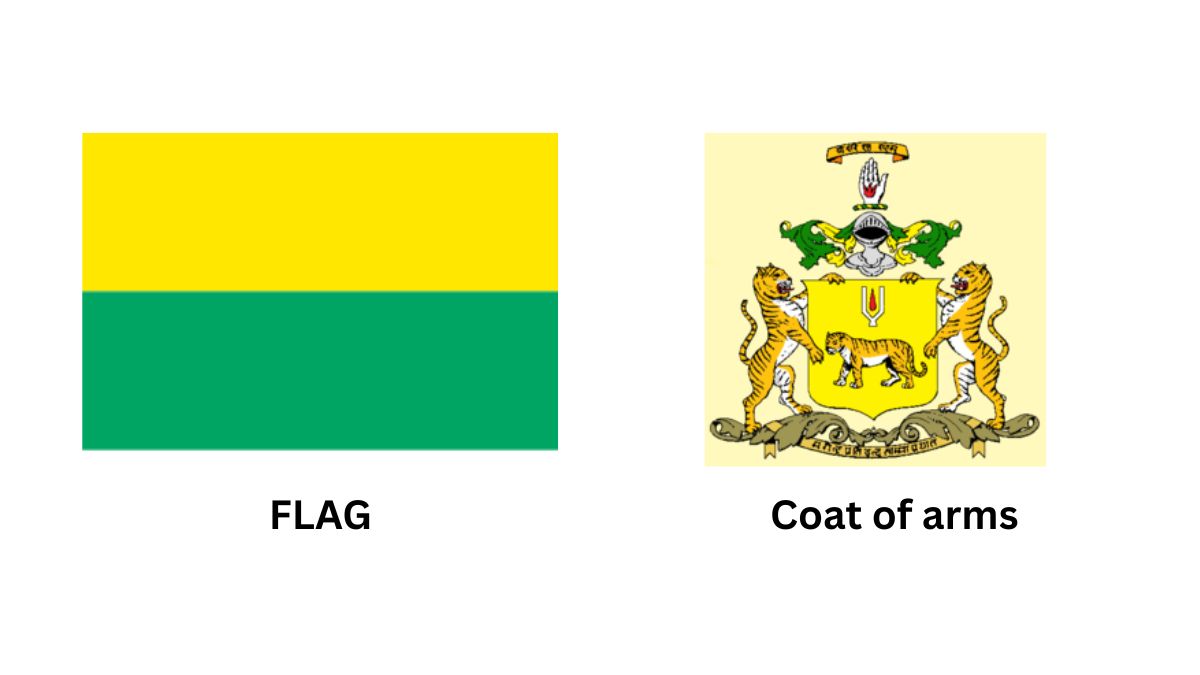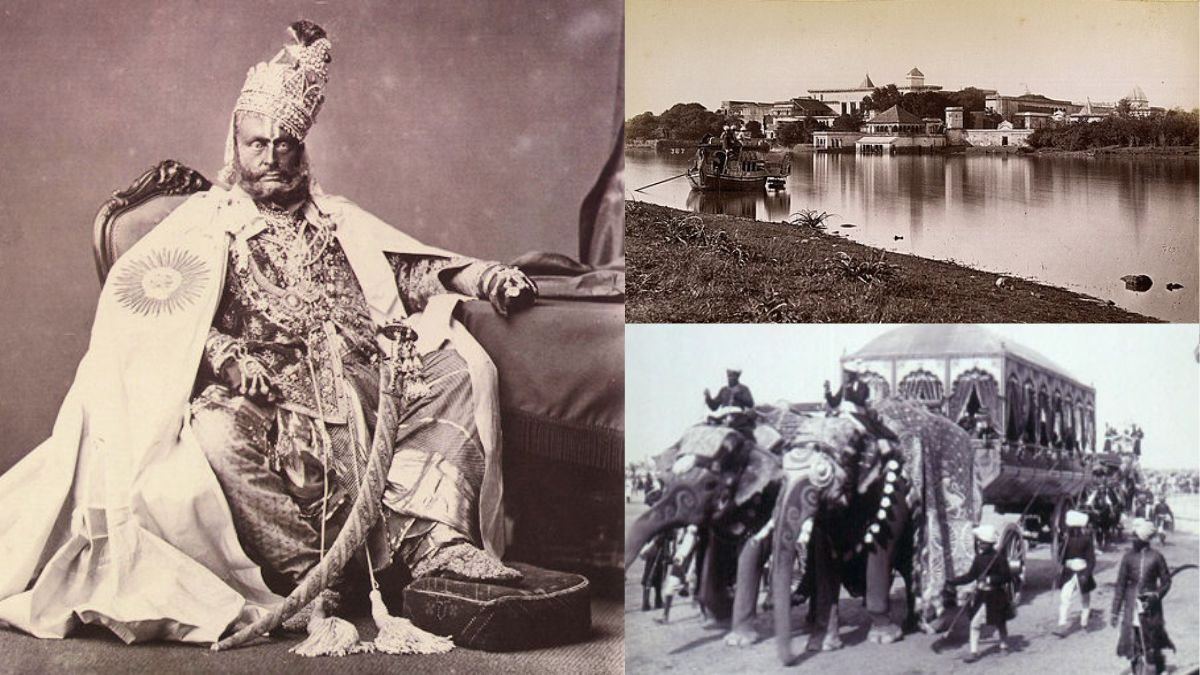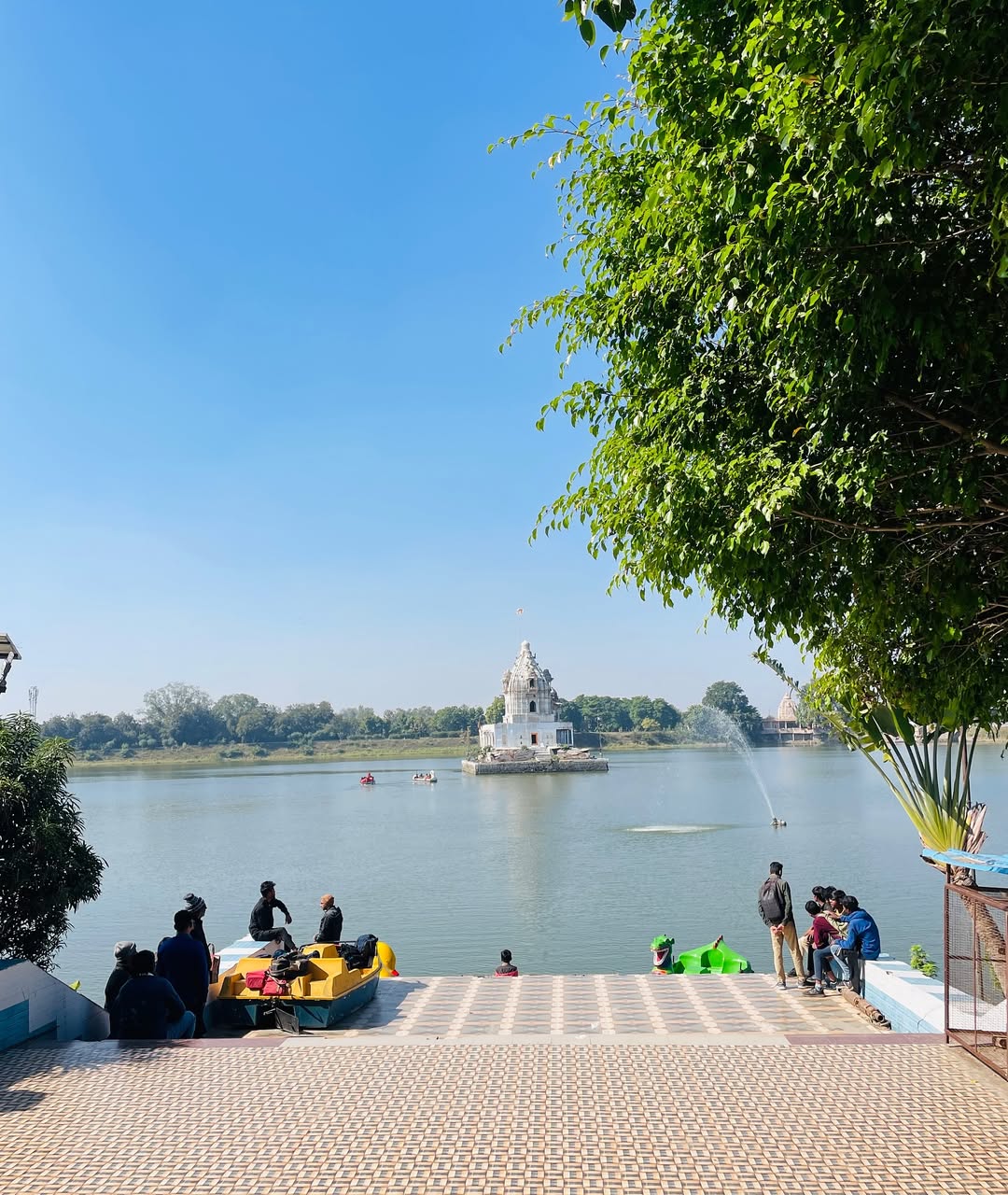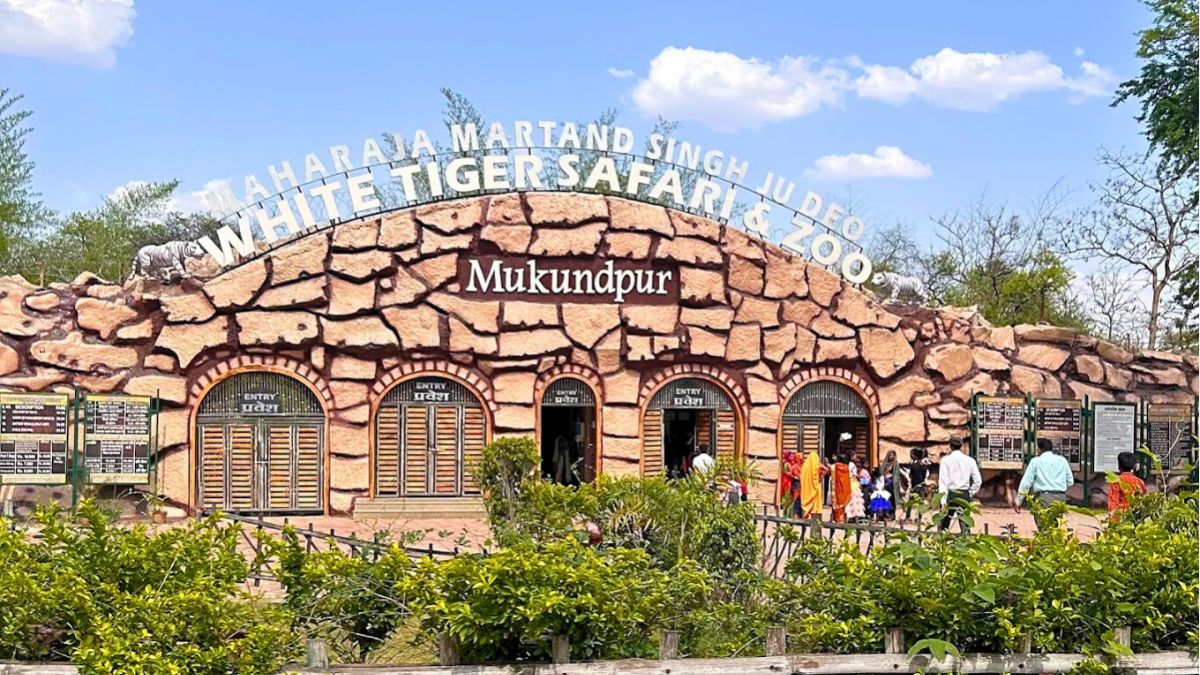Rewa is a culturally and historically significant city in Madhya Pradesh, India, and serves as the administrative and cultural center of the Bagelkhand region. Known for its association with the Baghela Rajput dynasty, Rewa has a rich historical legacy, a vibrant cultural identity rooted in the Bagheli dialect, traditional festivals, and Hindustani classical music. The city is notable for its geographical diversity, heritage architecture, and the discovery of the first white tiger, a symbol now linked to wildlife conservation efforts. In modern times, Rewa has developed as an educational, infrastructural, and economic hub, blending tradition with growing urban aspirations.
🔗 Read also: Infinix Note 50s 5G: सिर्फ ₹15,999 में, AMOLED डिस्प्ले और जबरदस्त कैमरा, जानिए क्यों है ये मिड-रेंज का किंग!
II. Introduction: Rewa – The Heart of Bagelkhand

Rewa, located in the northeastern part of Madhya Pradesh, serves as the administrative center of both Rewa district and Rewa division. Its strategic position has long established it as a key urban, cultural, and governance hub within the historic Bagelkhand region. The city holds deep historical and cultural roots, having been the capital of the former princely state of Rewa ruled by the Baghela Rajput dynasty.
This royal legacy continues to shape Rewa’s cultural identity, which is enriched by Bagheli language and traditions, classical music heritage, and vibrant festivals. The name “Rewa” is commonly believed to be derived from an ancient name for the Narmada River, reflecting the city’s close connection to natural geography. Another interpretation links it to the Sanskrit word revā, meaning “swift” or “rapid,” possibly referring to the dynamic rivers and terrain that characterize the region.
III. Historical Trajectory: From Princely State to Modern Hub
Rewa’s history reflects a deep and continuous legacy of human settlement and political evolution, spanning thousands of years. Its development from ancient habitation sites to a modern administrative center is shaped by successive dynasties and pivotal historical shifts.
Ancient and Early Medieval Period (1000 BCE – 1200 CE)
Archaeological evidence suggests that the Rewa region has been inhabited since at least 1000 BCE. Excavations at sites like Baghahi, Deur Kothar, and Bansagar have unearthed Chalcolithic tools and other remnants, pointing to the presence of early human settlements and continuous cultural activity. References to the region in ancient Indian literature, along with its incorporation into the Chedi and Vatsa Mahajanapadas, affirm Rewa’s early political and strategic importance. During the Mauryan and Gupta periods, the area formed part of larger imperial networks, benefiting from economic integration and cultural exchange.
In the early medieval era, Rewa came under the rule of several influential dynasties, including the Kalachuris of Tripuri, the Chandelas, and the Kachchhapaghatas. These powers left behind a rich legacy of architecture and inscriptions, notably in the form of temples and stone edicts that still mark the landscape today. This layered heritage indicates that Rewa had established political, religious, and cultural significance long before the emergence of the Baghela dynasty. The enduring presence of these early civilizations provided the foundation upon which later rulers built, contributing to Rewa’s unique historical and cultural identity.
The Zenith of Baghela Rule (13th Century – 1947 CE)
The Baghela Rajputs, a branch of the Solanki (Chaulukya) dynasty of Gujarat, migrated to the region around the 13th century CE and established their rule in what came to be known as Bagelkhand. The founding of the Baghela state is credited to Vyaghra Deo, a Baghela prince, around 1236 CE. Initially, the capital was located at Bandhavgarh, but in 1618 CE, Maharaja Vikramaditya Singh shifted the capital to Rewa, solidifying its status as the political and cultural center of the Baghela kingdom.
The reign of Raja Ramchandra Singh Baghela (1555–1592 CE) marked a cultural golden age for Rewa. His court gained renown for its patronage of music, literature, and the arts. It was during his rule that Tansen, the legendary musician, and Birbal, the witty courtier—both of whom would later become part of Emperor Akbar’s Navratnas (nine jewels)—were associated with Rewa. Their emergence from Rewa’s royal court underscores the region’s importance as a hub of cultural and intellectual activity during the 16th century. This active cultivation of the arts by the Baghela rulers significantly shaped Rewa’s cultural legacy.
An important anecdote highlighting the close relationship between the Mughal Empire and the Baghela rulers is that Emperor Akbar, during his early youth (around age 10), is said to have taken refuge in Rewa. He reportedly spent part of his childhood alongside Prince Ramchandra Singh, which helped establish a lifelong bond between the two royal households.
Throughout the medieval and early modern periods, Rewa engaged in periodic conflicts with neighboring powers, including Orchha, Bundelkhand, and Mughal forces. Despite pressures from the Mughals, and later incursions by the Marathas, the principality of Rewa retained a considerable degree of autonomy, attributed in part to its strategic location and the resilience of its rulers.
The Baghela dynasty continued to govern the princely state until Indian independence in 1947, after which Rewa was merged into the Union of India, eventually becoming part of the newly formed state of Madhya Pradesh.
Colonial Era and British Paramountcy (1812–1947)

During the 19th century, Rewa State emerged as one of the largest and most prominent princely states in Central India under British paramountcy. The formal relationship between Rewa and the British East India Company was established through a treaty signed on October 5, 1812. This agreement was prompted by a Pindari raid that had originated from Rewa territory and extended into Mirzapur, compelling British intervention. Under the terms of the treaty, Raja Jaisingh (reigned 1809–1835) accepted British protection, agreed to submit disputes with neighboring chiefs to British arbitration, and permitted the movement and cantonment of British troops within his territories.
These stipulations marked a significant reduction in Rewa’s sovereignty, aligning it with the broader pattern of British political dominance over Indian princely states during the colonial period.
Despite the constraints of colonial suzerainty, Rewa distinguished itself through progressive internal reforms. During the reign of Maharaja Gulab Singh, the state became the first princely state in India to adopt Hindi as its official court language. Additionally, his administration is credited with establishing a responsive form of governance, which granted citizens the right to question royal decisions—an unusual measure for a princely state at the time. While some historical accounts suggest that administrative centralization increased during Gulab Singh’s rule, requiring his approval even for minor actions by local officials, these developments reflect a complex period of governance marked by both modernization and autocratic tendencies.
During the Indian Rebellion of 1857, Rewa State officially supported the British East India Company. Although there were initial sympathies within the court for local rebel leader Thakur Ranmat Singh, the Maharaja eventually complied with British demands and facilitated Ranmat Singh’s capture. This episode illustrates the delicate balance princely rulers maintained between local loyalties and obligations to the colonial power. The decision to align with the British, common among princely states during the rebellion, was often driven by a desire to preserve internal autonomy and dynastic stability amid widespread unrest.
By the time of Indian independence in 1947, Rewa had maintained its princely status for over a century under British paramountcy. The state’s subsequent integration into the Indian Union marked the end of monarchical rule and the beginning of its transformation into a modern administrative region within Madhya Pradesh.

Post-Independence Integration and Evolution (1947 – Present)
After the independence of India in 1947, Maharaja Martand Singh of Rewa State formally signed the Instrument of Accession, integrating the princely state into the Union of India. As part of the political reorganization of Central India, Rewa was merged into the newly created state of Vindhya Pradesh, which brought together various princely states from the Baghelkhand and Bundelkhand regions. Rewa was designated the capital of Vindhya Pradesh, reflecting its continued administrative and strategic importance in the post-colonial political framework.
In 1956, as part of the States Reorganisation Act, Vindhya Pradesh was merged with Madhya Bharat, Bhopal State, and Mahakoshal to form the present-day Indian state of Madhya Pradesh. This transition marked the formal end of Rewa’s political autonomy as a princely state and its integration into the democratic structure of the Republic of India.
Despite the dissolution of royal governance, Rewa retained its regional significance. Over the decades, the city evolved into a notable administrative, educational, and cultural center within Madhya Pradesh. Institutions such as Awadhesh Pratap Singh University, regional government offices, and cultural heritage sites have contributed to Rewa’s ongoing development and prominence. Its historical legacy as a princely capital, combined with modern infrastructure and civic institutions, continues to shape its identity in contemporary India.
IV. Cultural Tapestry: Traditions, Language, and Arts
Rewa is widely recognized as the cultural epicenter of the Bagelkhand region, a distinction rooted in its vibrant traditions, unique linguistic identity, and rich artistic heritage—particularly in the realm of music.
Linguistic Heritage
The primary language spoken in Rewa is Bagheli, a regional dialect classified under the Eastern Hindi group. Spoken predominantly across Bagelkhand in eastern Madhya Pradesh, Bagheli incorporates elements from Awadhi, Bundeli, and Chhattisgarhi, giving it a distinct phonetic and grammatical character. This linguistic synthesis reflects a long-standing history of cultural intermingling in Central India.
Despite its distinctive features, Bagheli is typically listed as a dialect of Hindi in Indian census documents, which results in its speakers being statistically assimilated under Standard Hindi. This administrative classification presents challenges to language preservation, as it can obscure Bagheli’s unique cultural identity. Nevertheless, the oral tradition of Bagheli remains strong, and local institutions such as Awadhesh Pratap Singh University offer academic courses in the language. These grassroots and scholarly efforts underscore a commitment to preserving and promoting Bagheli as a vital regional language.
Bagheli is also known by alternate names such as Baghelkhandi, Rimahi, and Riwai, and continues to serve as a medium of communication across a wide spectrum of social interactions within the region.
Festivals and Cultural Celebrations
Rewa’s cultural identity is prominently expressed through its vibrant festival calendar, where traditional celebrations reinforce social cohesion, spiritual devotion, and regional identity.
- Dussehra is one of the most significant festivals in Rewa, celebrated with dramatic Ramlila performances and the ceremonial burning of effigies of Ravana, Meghnath, and Kumbhakarna. These events are deeply tied to the city’s Rajput martial legacy, and large public gatherings underscore community participation and unity.
- Diwali, the Festival of Lights, is marked by widespread illumination of homes with diyas, firework displays, and communal feasting, celebrating the victory of light over darkness.
- Holi in Rewa is particularly notable for the centuries-old traditions maintained by the royal family. Celebrations extend over several days, with rituals such as offerings at Lord Jagannath temples, ceremonial gun salutes, and the distribution of Aatika Prasad (a traditional dish of kadhi and rice). Maharaja Vishwanath Singh Ju Dev, a descendant of the royal family and an accomplished Mridang player, contributed significantly to these cultural practices.
- Navaratri is observed with religious devotion and cultural performances including folk dances such as Garba and Dandiya Raas, symbolizing community spirit and the divine feminine.
- Other festivals include the Malmaas Festival (May), the Mahamrityunjaya Festival (February), and the Vindhya Mahotsava (April), which promotes regional art and heritage.
These festivals not only preserve historical and spiritual narratives, but also act as economic catalysts, boosting tourism and local markets through fairs and public celebrations.
Musical Legacy
Rewa has played a foundational role in the development of Hindustani classical music, a legacy primarily shaped by Tansen, one of the greatest musicians in Indian history. Tansen spent a major portion of his adult life in the court of Raja Ramchandra Singh (1555–1592 CE) of Rewa. Their close musical collaboration helped lay the groundwork for the Gwalior Gharana, one of the most influential schools of Hindustani music.
Royal patronage of music in Rewa continued into the 19th century, contributing to the region’s rich musical heritage. This tradition remains vibrant today through institutions such as Rhythm Music Classes and Rewa School of Music, which teach both classical and contemporary styles.
Notable contemporary artists like Rewa Natu, a distinguished vocalist trained in the Gwalior Gharana under the Guru-Shishya Parampara, exemplify the enduring musical culture of the city. She performs a wide repertoire, including Khyaal, Tarana, Thumri, Natyageet, and Bhajan, and also contributes academically as a faculty member at Bharati Vidyapeeth University, Pune.
Events such as “Ghunghru”, organized by the Ustad Alauddin Khan Sangeet and Kala Academy, serve to preserve and promote traditional music and dance forms. Held annually at the Krishna Raj Kapoor Auditorium, this two-day festival features performances by established and emerging artists from across India.
Rewa’s cultural landscape is thus characterized by a fusion of traditional continuity and modern expression. Its linguistic uniqueness, festive vibrancy, and musical richness position it as a crucial cultural hub in Madhya Pradesh, with significant contributions to India’s broader heritage.
Topography
Rewa is situated within the Vindhya plateau, characterized by its surrounding hills and extensive forests. This topography provides a distinct regional identity and influences local ecosystems. The Vindhya Range itself serves as a significant geographical demarcation, effectively dividing the vast Indo-Gangetic plains from the Deccan plateau region of India. This positioning has historically made Rewa a strategic location, influencing trade routes and cultural exchanges between northern and central India.
Due to their underlying horizontal sandstone structure, the mountains in the region tend to exhibit flat-topped, plateau-like formations. Rewa’s location within the Vindhya plateau and its surrounding hilly and forested terrain provided natural defensive advantages.
This geographical feature likely contributed to the city’s ability to maintain “semi-autonomy” despite frequent conflicts with neighboring kingdoms and imperial forces [User Query]. Furthermore, the Vindhya Range’s role as a “dividing line” between major Indian geographical zones positioned Rewa at a strategic crossroads, influencing its historical interactions, trade routes, and its emergence as a significant political and cultural center. Thus, the local topography was a crucial determinant in shaping Rewa’s historical trajectory and its enduring resilience.
River Systems
The Rewa region is characterized by several significant rivers, including the Tons (Tamas) and Bichiya. These rivers are vital for local agriculture and contribute to the region’s natural beauty. The Vindhya mountains are the source of numerous tributaries that feed into the larger Ganga-Yamuna river system, with the Tons River being a prominent example. This network of rivers underscores the region’s hydrological importance within the broader Indian landscape.
Specific to the region’s natural wonders, the Bahuti Waterfall is formed by the River Nihai (also known as Odda), which subsequently flows into the Belan River, a tributary of the Tons River. The Chachai Waterfall is notably formed by the Beehar River. The presence of these major rivers and their tributaries, forming impressive waterfalls, highlights the role of waterways not only as essential lifelines for the population and agriculture but also as significant natural attractions.
The waterfalls, such as Keoti, Bahuti, and Chachai, are major draws for tourism, emphasizing the dual function of these river systems in supporting both human activity and ecological value. The natural flow of these rivers also contributes to the region’s overall ecological health and biodiversity.
Climate
Rewa experiences a humid subtropical climate, characterized by cold, misty winters, hot summers, and humid monsoon seasons. This climatic pattern dictates agricultural cycles and daily life. Summers typically begin in late March and extend until mid-June, with average temperatures around 30 °C (86 °F). May marks the peak of summer, where daily highs regularly exceed 45 °C (104 °F), with a record high of 48.2 °C (118.8 °F) recorded on May 28, 2024.
The monsoon season commences in late June and concludes in late September, bringing approximately 40 inches (1025 mm) of precipitation. During these months, the average temperature is around 25 °C (77 °F), accompanied by high humidity, often exceeding 83% in August. This period is crucial for groundwater recharge, as about 89.2% of the annual rainfall occurs during the southwest monsoon. Temperatures begin to rise again in late October, marking the transition to winter, which lasts until early March.
Winters in Rewa are cold and misty, with average temperatures around 15 °C (58 °F) and minimal rainfall. January is the coldest month, with temperatures occasionally dropping close to freezing at night. The total annual rainfall averages approximately 1128 mm (44 inches). The distinct seasonal variations, particularly the intense summer heat and the concentrated monsoon rainfall, significantly influence the region’s agricultural practices, water resource management, and overall environmental conditions.
VI. Architectural Landmarks and Natural Wonders
Rewa’s landscape is adorned with historical structures and breathtaking natural formations, each telling a story of its rich past and ecological significance.
Rewa Fort and Museum
The Rewa Fort, located in the heart of the city, is a magnificent structure that showcases the grandeur of the Baghel dynasty. Its history dates back to the 13th century when construction began under the Baghela Rajputs, though it was completed in the 17th century by Raja Vikramaditya. Perched atop a hill overlooking the Bichhiya River, the fort was strategically designed with solid defenses, including high walls, watchtowers, and a moat.
The fort’s architecture is a captivating blend of Rajput, Mughal, and British styles, reflecting the various influences it absorbed over centuries of rule. The main entrance, Suraj Pol, leads to a courtyard housing the Diwan-e-Aam (public audience hall) and Diwan-e-Khas (private audience hall). Notable structures within the complex include the two-story Rani Mahal (Queen’s Palace) with its balconies and courtyards, and the Sheesh Mahal (Mirror Palace), famous for its intricate mirror work. The fort also integrates religious diversity, featuring temples like the Hanuman Temple and Jagannath Temple, built in the Nagara architectural style with exquisite carvings, alongside the Jama Masjid.
Today, Rewa Fort is a popular tourist destination, converted into a museum in 1967 to display the region’s rich history and cultural heritage. The museum houses a collection of ancient weapons, coins, paintings, and sculptures, offering profound insights into the Baghel dynasty’s royal lifestyle and the area’s past. The fort is open to visitors from 10 am to 7 pm, with free entry, except on Mondays and Saturdays when it is closed. Visitors can also find affordable rooms for stays and a restaurant with scenic views of the Bichhiya River.
Govindgarh Palace
Situated approximately 13 km from Rewa, Govindgarh Palace served as the erstwhile summer retreat of the Rewa royals. Built in 1853 by Raja Raghuraj Singh, this fort-like structure was a royal residence on the picturesque shores of Lake Govindgarh for nearly a century. The palace complex included various buildings and temples, and it notably housed Mohan, the first white tiger discovered in India.
Following India’s independence and the decline of the princely states, Govindgarh Fort was vacated. A museum was later established within the building. In 2018, plans were announced to refurbish the fort and convert it into a luxury hotel, aiming to preserve its heritage in a new way. As of recent updates, the palace is currently closed to tourists as it is undergoing renovation for this conversion. While the exact completion date is not specified, some sources suggest it might reopen as a luxurious hotel in 4-5 years from the time of that information. Despite being closed, its location offers a beautiful lake view, making it a scenic spot for families, especially during winters. The surrounding greenery contributes to a serene and peaceful atmosphere.
Keoti and Bahuti Waterfalls
Rewa is home to some of Madhya Pradesh’s most spectacular waterfalls, including Keoti and Bahuti, which are among the highest in the state.
Keoti Waterfall: Formed by the Mahana River, Keoti Waterfall cascades from a height of 130 meters (427 feet) from the Chitrakoot Hills. It offers breathtaking views and serene surroundings, making it a popular spot for nature lovers, history buffs, and photographers. Located just 35 km from Rewa, the area around Keoti Fall is ecologically significant, with lush forests teeming with diverse flora and fauna, providing opportunities for wildlife spotting and nature photography. Adventure activities like trekking and rock climbing are also popular. The waterfall is also a holy site, cherished by the local community.
Conservation efforts are underway, with a petition filed with the National Green Tribunal against illegal mining and unauthorized construction damaging the Keoti village forest, and a demand for its declaration as a Biodiversity Heritage Site.
Bahuti Waterfall: Recognized as the highest waterfall in Madhya Pradesh, Bahuti Waterfall plunges from 198 meters (650 feet). It is formed by the River Odda (also known as Nihai), which joins the Belan River, a tributary of the Tons River. This “hidden gem” offers breathtaking views and a peaceful escape into nature, ideal for picnics, photography, and relaxation. Located about 65 km from Rewa, the surrounding rugged terrain and trails offer opportunities for adventure.
The area around Bahuti Falls is home to fauna species such as Hyena, Nilgai, Jackal, Bengal Monster Lizard, Indian Roller Bird, Indian Grey Hornbill, and Oriental Magpie Robin. While the ecological importance is primarily tied to its natural beauty and riverine formation, the presence of diverse wildlife suggests a healthy ecosystem. The best time to visit is during the post-monsoon season (October-December) for optimal views and nature photography.
Rani Talab

Rani Talab is an ancient sacred pond in Rewa [User Query]. It is one of the oldest water bodies in the district and holds significant cultural and recreational importance for both locals and tourists. The lake is steeped in history, with an island in its center housing the iconic Rani Mahal, a historical palace known for its architectural beauty that reflects the grandeur of bygone eras. Near the talab, there is a temple dedicated to Goddess Kali, considered very powerful by locals who believe their wishes are fulfilled there. A grand Puja is held annually during Diwali, specifically on Kali Puja, and a big fair during Navaratri.
The tranquil ambiance of Rani Talab, encompassed by lush greenery and shimmering waters, attracts visitors seeking a quiet spot for relaxation and contemplation. It provides a scenic backdrop for leisurely walks, picnics, and boating activities. While its natural beauty is appreciated, maintenance and cleanliness have occasionally been concerns, with visitors emphasizing the need for consistent efforts to preserve its pristine environment. Rewa Nagar Nigam has been credited with making it a well-maintained spot, with a nominal entry fee.
Venkat Bhawan
Venkat Bhawan is a royal guest house turned heritage site in Rewa [User Query]. This architectural marvel was constructed in 1907 by Maharaja Venkatraman Singh. Its primary purpose was to provide employment to people during the famine period of 1894, making it a significant famine relief project that also symbolized a cultural renaissance in Rewa.
The Bhavan is renowned for its unique Saracenic style of architecture, characterized by an expansive central hall adorned with Belgian glass and intricate cast-iron railings. Its walls feature stunning carvings of Lord Shiva and Parvati, and it includes a secret tunnel historically used by kings during wars. The outer wall of the temple has a total of twelve doors. Currently, the property is maintained by the Madhya Pradesh State Archeology Department and functions as a heritage hotel, similar to some other forts in Rewa. Conservation efforts focus on structural stabilization, removal of biological growth, and preservation of decorative features like glass inlay and stucco work, with an estimated cost of Rs. 15.47 crore. The conservation project aims to serve as a model for heritage preservation through sustainable practices and integration with regional tourism and educational programs.
VII. White Tiger Legacy: Conservation and Controversy
Rewa is famously known as the “Land of the White Tiger”. This association stems from the discovery of Mohan, the first white tiger, in the region in 1951. Maharaja Martand Singh Judeo, the last ruler of Rewa, was instrumental in Mohan’s capture from the Govindgarh jungle in 1951 and subsequently initiated a breeding program to preserve this rare genetic trait. White tigers from Rewa were later sent to zoos around the world, establishing Mohan as the progenitor of the global captive white tiger lineage.
Scientific and Conservation Implications
White tigers are not a distinct subspecies but rather a leucistic morph of the Bengal tiger, meaning they possess a rare color mutation caused by a recessive gene that results in a lack of pigmentation in their fur. This genetic variation occurs naturally in the wild approximately once in every 10,000 tiger cub births, making them incredibly rare. The last known wild white tiger was reportedly killed in 1958.
In captivity, white tigers exist primarily due to inbreeding, a practice driven by the desire to maintain this rare trait for exhibition. This inbreeding, however, leads to severe deformities and medical conditions in cubs, with studies indicating a high mortality rate (e.g., 80% of inbred cubs dying shortly after birth). Common health issues include immune system deficiencies, scoliosis, hip dysplasia, neurological disorders, cleft palates, and crossed eyes. Only about one in 30 white tigers born in captivity is considered “suitable” for public display.
From a conservation perspective, breeding white tigers serves no ecological or conservation purpose. Their unique white coat makes them unsuitable for survival in the wild due to a lack of camouflage, and releasing captive-bred tigers into the wild poses significant risks by potentially advancing weak genes within the population. Wildlife experts and activists often question the ecological value of such projects, arguing that they are a waste of resources with negligible conservation benefit, primarily driven by exotic value and tourism revenue. The propagation of weaker genes through inbreeding is seen as counterproductive to genuine biodiversity conservation efforts.
White Tiger Breeding Center and Mukundpur Safari

Despite these scientific concerns, the Central Zoo Authority (CZA) has approved India’s first white tiger breeding center in Govindgarh, Rewa district. This project, initially approved in principle in 2011, is planned near Mukundpur’s white tiger safari, which is the state’s only existing white tiger tourism facility. The breeding center is part of a revised master plan for the Maharaja Martand Singh Judeo White Tiger Safari and Zoo in Mukundpur.
The stated objectives of this initiative are to conserve biodiversity, boost wildlife tourism, and generate local employment. Madhya Pradesh’s Deputy Chief Minister, Rajendra Shukla, has emphasized the state’s commitment to biodiversity conservation through this project. The Additional Principal Chief Conservator (wildlife) of Madhya Pradesh has stated that a scientific study of white tiger breeding will be conducted at the proposed center. This demonstrates a tension between the perceived conservation benefits and the ethical implications of breeding animals with known genetic vulnerabilities for display. The project highlights a complex interplay between conservation goals, economic development through tourism, and the scientific debate surrounding the breeding practices of white tigers.
VIII. Socio-Economic Dynamics: Education, Infrastructure, and Economy
Rewa’s contemporary socio-economic landscape is characterized by its growing educational institutions, evolving transportation networks, and a dynamic economy driven by both traditional industries and modern development initiatives.
Education and Institutions
Rewa is home to several significant educational institutions that serve as pillars of regional development.
Awadhesh Pratap Singh University (APSU): Established in 1968 and recognized by the University Grants Commission (UGC) in 1972, APSU is a public, co-educational university located on a 246.20-acre campus north of Rewa city. Named after Captain Awadhesh Pratap Singh, a freedom fighter, the university is affiliated with nearly 238 colleges across seven districts of Madhya Pradesh (Anuppur, Rewa, Satna, Shahdol, Sidhi, Singrauli, and Umaria), extending its educational reach to remote areas through distance learning.
APSU offers a wide array of academic programs, including undergraduate, postgraduate, diploma, and PhD levels across various domains such as Arts, Commerce, Management, Law, Sciences, Engineering, Education, Social Sciences, Languages, Computing, Life Sciences, Physical Sciences, Mathematical Sciences, Environmental Studies, and Biotechnology. The university emphasizes advanced knowledge and research skills, encouraging interdisciplinary studies and collaborative research with faculty from different disciplines.
Its research output is notable, with 848 academic publications and 7,256 citations, particularly in Biology, Chemistry, Physics, and Engineering. Recent research contributions include studies on digital innovation and Sustainable Development Goals, cosmic history in modified gravity theories, profitability in the Indian inorganic chemical sector, and groundwater potential mapping. The university’s research focus on areas like public health and environmental science within the local context, such as a study on groundwater potential zones in the Bichhiya river basin , demonstrates its direct contribution to regional development challenges. Its engagement with industry-academia collaboration aims to provide students with practical experience and exposure to real-world problems.
Government Engineering College (REC): Formerly known as Government Engineering College (GEC), REC was established in 1964 and is an autonomous institution funded by the Government of Madhya Pradesh. Located on a 250-acre campus, it offers B.Tech programs in Civil, Mechanical, Electrical, Electronics & Communication, and Computer Science, as well as M.Tech courses.
REC has a dedicated placement cell and a Centre of Innovation, Incubation, Entrepreneurship, and Industry Relations (E-Cell) that promotes entrepreneurial activities. Notable alumni include Rajendra Shukla, the Deputy Chief Minister of Madhya Pradesh. The college has achieved recognition, with a student securing All India Rank 13 in the GATE Exam in 2022 and the college winning first place in the Smart India Hackathon. REC’s E-Cell actively fosters entrepreneurship, and its alumni are placed in leading companies, indicating a direct contribution to local employment and the startup ecosystem.
Rewa Medical College (Shyam Shah Medical College): Established in 1963, Shyam Shah Medical College (SSMC) is a well-known institution affiliated with Madhya Pradesh Medical Science University (MPMSU). It offers MBBS, MD, MS, and PG Diploma courses with specializations across various medical fields such as Pathology, Ophthalmology, Anaesthesia, General Medicine, Pediatrics, and Psychiatry. SSMC has a Multi-Disciplinary Research Unit (MDRU), sanctioned by the Department of Health Research, Government of India, to promote indigenous quality research, particularly focusing on Non-Communicable Diseases.
The MDRU has launched several ongoing research projects, including studies on gene polymorphism in congenital ocular anomalies, effect of zoledronic acid on hip fractures, hematological profiles in malnourished children, and drug discovery for anti-diabetic agents. The college encourages research through projects, conferences, and seminars, contributing to its high rankings among medical colleges in Madhya Pradesh and nationally.
A recent study highlighted a high incidence of abnormal Pap smears and low awareness of cervical cancer among women in Rewa, leading to urgent recommendations for targeted screening and educational interventions, particularly for underprivileged women. This demonstrates SSMC’s direct engagement with public health challenges in the Rewa region and its commitment to improving local health outcomes through research and policy recommendations.
Transport and Connectivity
Rewa is undergoing significant developments in its transportation infrastructure, enhancing its connectivity within Madhya Pradesh and to major Indian cities.
Rail Connectivity: Rewa is connected by rail within the West-Central Railway Zone. Rewa railway station (Code: REWA) is directly linked to Satna via a 50 km branch line. From Satna, it connects to major cities like Allahabad (Prayagraj), Jabalpur, Varanasi, Kanpur, and Lucknow. This network provides crucial access for passengers and freight, supporting economic activities and facilitating regional mobility.
Road Network Development: Rewa is well-connected by road, with National Highways (NH 7, NH 27, NH 35, and NH 75) passing through the city. The state government is actively investing in road infrastructure, with projects worth ₹22,500 crore for 10,000 km of roads and ₹10,463 crore for 474 bridges and flyovers currently under progress across Madhya Pradesh. Rewa is part of major corridor initiatives such as the Vindhya Expressway, which aims to connect backward regions of the state to mainstream development. The Rewa-Sidhi section of National Highway 39 is undergoing 4-laning, including the construction of Madhya Pradesh’s first 6-lane twin tunnel (2.28 km) near Gurh, which has reduced travel time between Rewa and Sidhi significantly (from 2.5 hours to 45 minutes). This project serves as a milestone for the Vindhya Region, promising socio-economic development by improving safety and convenience for commuters. The state’s broader road network development, including the Vindhya Expressway, is expected to enhance regional integration and support industries like stone mining, brassware, and carpet manufacturing.
Airport Development (UDAN Scheme): Rewa has a domestic airport under development as part of India’s UDAN (Ude Desh ka Aam Nagrik) scheme, which aims to enhance regional air connectivity. The airport, located in Chorhata (11 km from the city center), is currently operational for government and private helicopters and is expected to be fully operational for commercial flights by 2025. The development project, with an estimated cost of ₹300 crore, includes runway extension and terminal construction, capable of accommodating ATR 72 aircraft. While official flight schedules are still evolving, initial plans suggest connections to Bhopal, Indore, New Delhi, and Mumbai. The inauguration of a new terminal building was virtually performed by Prime Minister Narendra Modi on October 20, 2024, with a flight flagged off between Rewa and Bhopal. This project is anticipated to significantly boost tourism, trade, and employment in the Vindhya region, attracting investments and improving the quality of life for residents. The improved air connectivity is expected to open new markets and alleviate logistical challenges for businesses, creating new jobs in sectors like tourism, hospitality, and transportation.
Economic Landscape and Development
Rewa district’s economy is characterized by a mix of traditional sectors and emerging industries, with ongoing efforts to foster growth and address developmental challenges.
Key Industries: The district’s industrial landscape is significantly shaped by a robust cement industry, with notable facilities such as the Jaypee Rewa Cement Plant. Agriculture remains a thriving economic activity, with major crops including rice, wheat, and pulses. Rewa has also emerged as a significant exporter of optical fiber cable, electric transformer components, and electric conductors. Iron ore, extensively used in construction and manufacturing, is another important export.
A prominent economic focus for Rewa is its “One District One Product” (ODOP) initiative, highlighting “Bamboo Crafts”. Leveraging its abundant bamboo forests, local artisans create a wide array of bamboo products, such as furniture and decorative items. This initiative capitalizes on the region’s natural resources and skilled craftsmanship to foster economic growth and promote sustainable development, with growing demand for bamboo yarn and furniture offering significant export potential.
Employment and Per Capita Income: The labor force participation rate in Rewa district was 70.26% for the year 2023-2024. The main source of income in the district is from the agriculture sector. The per capita income for Rewa district was ₹90,533 for the year 2020-2021. For Madhya Pradesh as a whole, the per capita net income at current prices increased to ₹1,40,583 in 2022-23 , with a projected per capita GDP of US$1,850 for 2023-24. These figures indicate a reliance on agriculture and highlight the need for diversified economic growth to improve living standards.
Development Projects and Future Outlook: Rewa is at the cusp of a major transformation, with urban development focused on residential townships, road expansions, smart city initiatives, new commercial spaces, and industrial parks. The Madhya Pradesh Industrial Promotion Policy 2025 aims to position the state, including Rewa, as a hub for traditional, emerging, and high-value-added sectors, focusing on attracting large-scale industries, foreign direct investments, and R&D-driven enterprises. This policy includes sector-specific incentives, streamlined regulatory processes, and strengthening of critical infrastructure. Rewa is recognized as one of the “growth centers” in Madhya Pradesh, with 231 industrial areas notified across the state.
Key development projects with expected completion timelines include:
Smart City Infrastructure (Phase 2): Mid-2026, aiming for enhanced city amenities and better quality of life. Rewa is part of the Smart Cities Mission, which focuses on core infrastructure, sustainable environment, and quality of life through smart solutions, including integrated traffic management, waste management, and renewable energy solutions.
University Road Expansion: Early 2026, to improve connectivity and increase property demand.
New Residential Townships: 2025–2027, expected to lead to an affordable housing boom.
Rewa Bypass Road Upgrade: End of 2025, for smoother logistics and increased commercial property value.
New Commercial Malls (Bypass Road): Mid-2026, contributing to retail and rental market growth.
Industrial Park Near Chorhata: 2026–2027, projected to create more job opportunities and rental housing demand.
These developments are expected to significantly impact property prices, with projected appreciation of 25%–35% by 2027. Locations like Bypass Road, University Road, Chorhata Zone, and Amaiya Colony are identified as prime investment areas.
Economic Challenges: Despite the positive outlook, Rewa faces challenges common to developing regions. The construction industry, a major employer, grapples with human capital issues such as skill shortages, labor turnover, and safety concerns, which can impede operational efficiency and project timelines. While the state is addressing skill gaps through policies and training programs, a significant portion of the population (only 1.2% of those aged 15+ having formal vocational training) still lacks adequate skills, posing an impediment to economic development and job creation. Environmental concerns, such as the need for sustainable practices in construction and waste management, also present challenges. The state’s economic growth is also dependent on overcoming external factors like land acquisition issues and regulatory approvals for infrastructure projects.
The development of new airports, expressways, and industrial parks aims to enhance connectivity and attract investment, thereby diversifying the economy beyond its traditional agricultural base and creating more skilled employment opportunities. The focus on “green manufacturing practices” and “sustainable industrial development” in state policies indicates an awareness of environmental considerations in economic growth.
IX. Conclusions
Rewa, Madhya Pradesh, stands as a city deeply rooted in history, yet actively shaping its future. Its identity as the cultural and administrative heart of Bagelkhand is a product of millennia of human habitation, successive dynastic influences, and a unique blend of cultural traditions. The city’s ancient foundations, evidenced by archaeological finds, laid the groundwork for a rich historical tapestry upon which the Baghela Rajput dynasty built a powerful princely state. The patronage of arts under rulers like Raja Ramchandra Singh fostered an environment of cultural excellence, producing figures like Tansen and Birbal, whose legacies continue to define Rewa’s musical and scholarly heritage. This historical cultivation of culture continues to manifest in vibrant festivals and a strong regional language, Bagheli, which local and academic efforts strive to preserve amidst broader linguistic trends.
The city’s strategic location within the Vindhya plateau has historically provided both defensive advantages and a pivotal position for trade and cultural exchange, contributing to its enduring significance despite external pressures. The 1812 treaty with the British, while curtailing full autonomy, also marked a period of administrative reforms, including the progressive adoption of Hindi as the court language and early forms of responsive governance. This highlights a complex historical dynamic where pragmatic political decisions coexisted with forward-thinking internal policies.
Rewa’s natural landscape, characterized by its hills, forests, and impressive waterfalls like Keoti and Bahuti, offers significant ecological value and a growing potential for eco-tourism. The city’s unique association with the white tiger, through the discovery of Mohan and subsequent breeding programs, positions it at the forefront of a global conservation debate, balancing historical legacy with scientific and ethical considerations surrounding captive breeding.
In its contemporary phase, Rewa is evolving into a dynamic socio-economic hub. Its educational institutions, particularly Awadhesh Pratap Singh University and Shyam Shah Medical College, are not only providing academic and professional training but also actively contributing to regional development through research focused on local challenges like public health and environmental sustainability. Significant investments in transportation infrastructure, including the ongoing airport development under the UDAN scheme and the ambitious Rewa-Sidhi highway project, are poised to enhance connectivity, attract investment, and stimulate economic growth. While traditional industries like cement and agriculture remain vital, the “One District One Product” initiative for bamboo crafts and the broader state industrial policies signal a strategic shift towards diversified and sustainable economic development. Addressing challenges such as skill gaps and ensuring environmentally conscious growth will be crucial for Rewa to fully realize its potential as a modern, self-reliant city within Madhya Pradesh.







